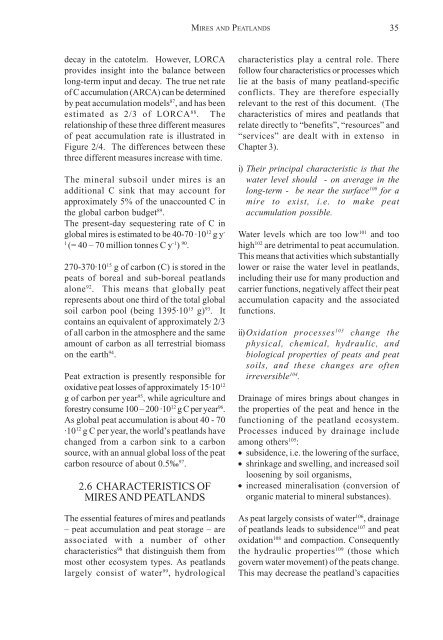wise use of mires and peatlands - Peatland Ecology Research Group
wise use of mires and peatlands - Peatland Ecology Research Group
wise use of mires and peatlands - Peatland Ecology Research Group
You also want an ePaper? Increase the reach of your titles
YUMPU automatically turns print PDFs into web optimized ePapers that Google loves.
MIRES AND PEATLANDS35decay in the catotelm. However, LORCAprovides insight into the balance betweenlong-term input <strong>and</strong> decay. The true net rate<strong>of</strong> C accumulation (ARCA) can be determinedby peat accumulation models 87 , <strong>and</strong> has beenestimated as 2/3 <strong>of</strong> LORCA 88 . Therelationship <strong>of</strong> these three different measures<strong>of</strong> peat accumulation rate is illustrated inFigure 2/4. The differences between thesethree different measures increase with time.The mineral subsoil under <strong>mires</strong> is anadditional C sink that may account forapproximately 5% <strong>of</strong> the unaccounted C inthe global carbon budget 89 .The present-day sequestering rate <strong>of</strong> C inglobal <strong>mires</strong> is estimated to be 40-70 ·10 12 g y -1(= 40 – 70 million tonnes C y -1 ) 90 .270-370·10 15 g <strong>of</strong> carbon (C) is stored in thepeats <strong>of</strong> boreal <strong>and</strong> sub-boreal peatl<strong>and</strong>salone 92 . This means that globally peatrepresents about one third <strong>of</strong> the total globalsoil carbon pool (being 1395·10 15 g) 93 . Itcontains an equivalent <strong>of</strong> approximately 2/3<strong>of</strong> all carbon in the atmosphere <strong>and</strong> the sameamount <strong>of</strong> carbon as all terrestrial biomasson the earth 94 .Peat extraction is presently responsible foroxidative peat losses <strong>of</strong> approximately 15·10 12g <strong>of</strong> carbon per year 95 , while agriculture <strong>and</strong>forestry consume 100 – 200 ·10 12 g C per year 96 .As global peat accumulation is about 40 - 70·10 12 g C per year, the world’s peatl<strong>and</strong>s havechanged from a carbon sink to a carbonsource, with an annual global loss <strong>of</strong> the peatcarbon resource <strong>of</strong> about 0.5‰ 97 .2.6 CHARACTERISTICS OFMIRES AND PEATLANDSThe essential features <strong>of</strong> <strong>mires</strong> <strong>and</strong> peatl<strong>and</strong>s– peat accumulation <strong>and</strong> peat storage – areassociated with a number <strong>of</strong> othercharacteristics 98 that distinguish them frommost other ecosystem types. As peatl<strong>and</strong>slargely consist <strong>of</strong> water 99 , hydrologicalcharacteristics play a central role. Therefollow four characteristics or processes whichlie at the basis <strong>of</strong> many peatl<strong>and</strong>-specificconflicts. They are therefore especiallyrelevant to the rest <strong>of</strong> this document. (Thecharacteristics <strong>of</strong> <strong>mires</strong> <strong>and</strong> peatl<strong>and</strong>s thatrelate directly to “benefits”, “resources” <strong>and</strong>“services” are dealt with in extenso inChapter 3).i) Their principal characteristic is that thewater level should - on average in thelong-term - be near the surface 100 for amire to exist, i.e. to make peataccumulation possible.Water levels which are too low 101 <strong>and</strong> toohigh 102 are detrimental to peat accumulation.This means that activities which substantiallylower or raise the water level in peatl<strong>and</strong>s,including their <strong>use</strong> for many production <strong>and</strong>carrier functions, negatively affect their peataccumulation capacity <strong>and</strong> the associatedfunctions.ii) Oxidation processes 103 change thephysical, chemical, hydraulic, <strong>and</strong>biological properties <strong>of</strong> peats <strong>and</strong> peatsoils, <strong>and</strong> these changes are <strong>of</strong>tenirreversible 104 .Drainage <strong>of</strong> <strong>mires</strong> brings about changes inthe properties <strong>of</strong> the peat <strong>and</strong> hence in thefunctioning <strong>of</strong> the peatl<strong>and</strong> ecosystem.Processes induced by drainage includeamong others 105 :● subsidence, i.e. the lowering <strong>of</strong> the surface,● shrinkage <strong>and</strong> swelling, <strong>and</strong> increased soilloosening by soil organisms,● increased mineralisation (conversion <strong>of</strong>organic material to mineral substances).As peat largely consists <strong>of</strong> water 106 , drainage<strong>of</strong> peatl<strong>and</strong>s leads to subsidence 107 <strong>and</strong> peatoxidation 108 <strong>and</strong> compaction. Consequentlythe hydraulic properties 109 (those whichgovern water movement) <strong>of</strong> the peats change.This may decrease the peatl<strong>and</strong>’s capacities
















